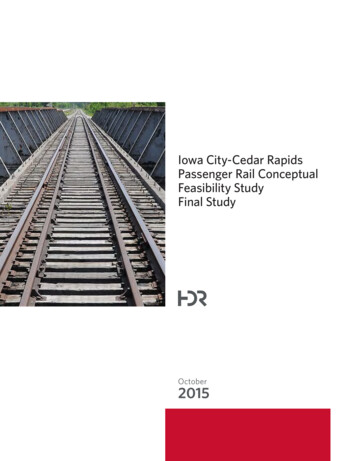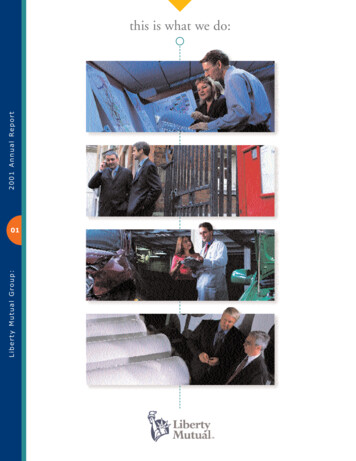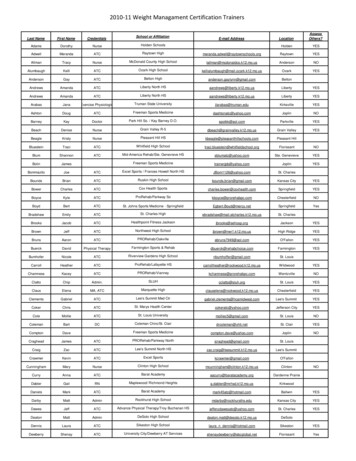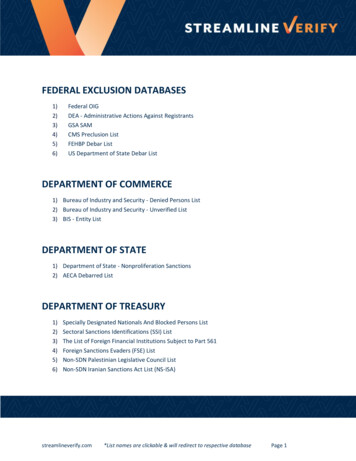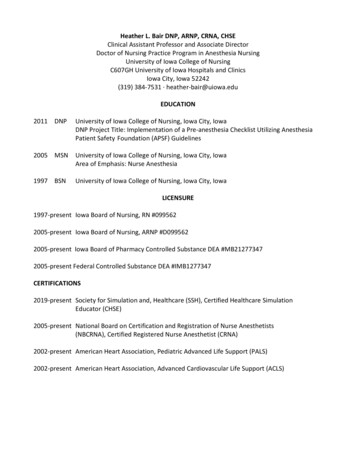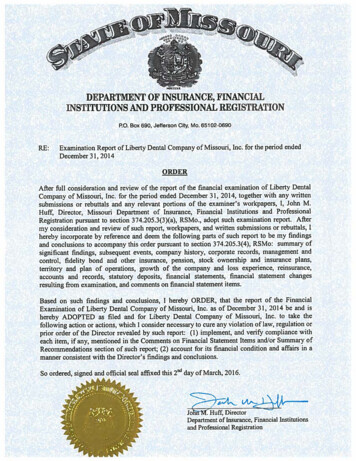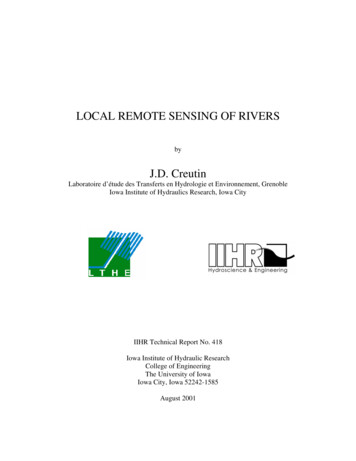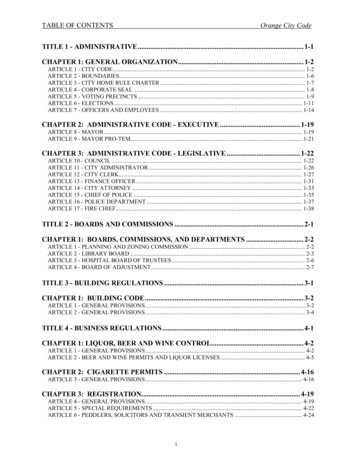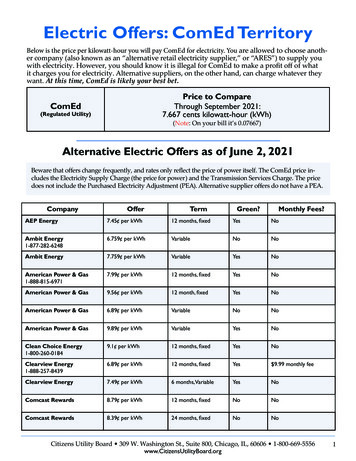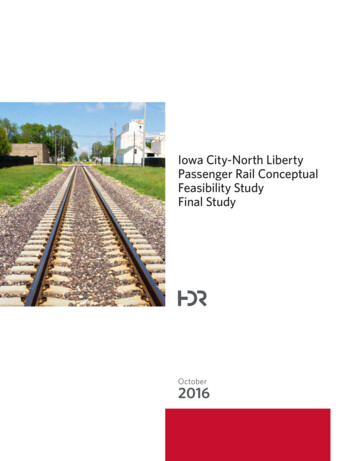
Transcription
Iowa City-North LibertyPassenger Rail ConceptualFeasibility StudyFinal StudyOctober2016
ContentsExecutive Summary21. Background42. Existing Corridor Conditions52.1 Corridor Service Area, Intersections, and Connectivity52.2 Corridor History62.3 Present General Corridor Characteristics73. Conceptual Equipment and Service Plan183.1 Conceptual Equipment Plan183.2 Conceptual Service Plan194. Infrastructure and Equipment Requirements andConceptual Cost Estimate244.1 Capital Cost Estimate Approach244.2 Operations and Maintenance Cost Approach284.3 Presentation of Conceptual Cost Estimate294.4 Alternatives to Infrastructure and EquipmentRequirements and Conceptual Cost Estimate314.5 Additional Potential Future Phased Implementations355. Federal Safety and Governance RegulatoryRequirements365.1 Federal Transit Administration365.2 Surface Transportation Board415.3 Environmental Review42
Iowa City-North Liberty Passenger Rail Conceptual Feasibility Study Final Study Executive SummaryThe purpose of the Iowa City-North Liberty Passenger Rail Conceptual Feasibility Study (the Study) is to examinethe conceptual feasibility of a passenger rail service operating between Iowa City, Iowa, and North Liberty,Iowa. The corridor under consideration in this study is the Cedar Rapids & Iowa City Railway (CRANDIC), anactive freight railroad over which no passenger rail services are offered at present. The 7.1-mile CRANDICCorridor Study Area (the Corridor) is between Gilbert Street in central Iowa City, Iowa, and Forever GreenRoad in North Liberty, Iowa.CRANDIC, the Iowa Department of Transportation (Iowa DOT), and the Metropolitan Planning Organizationof Johnson County, Iowa (MPOJC) selected HDR as its consultant team for the Study. The railroad, Iowa DOT,MPOJC, and other local project stakeholders participated in, contributed to, and informed the development ofthe Study through coordination with HDR during the life of the project.The Study was divided into the following tasks, which culminated in this report: Background – Describe the background of recently completed and ongoing passenger rail feasibility studyof the Corridor. Existing Corridor Conditions – Describe the existing conditions and infrastructure on theCRANDIC Corridor. Conceptual Equipment and Service Plan – Describe the general characteristics of the mode of passengerrail service and equipment selected by stakeholders and its applicability to service in the Corridor. Conceptual Cost Estimate – Develop the probable conceptual capital and operations and maintenancecosts for the selected mode of passenger rail service assessed for potential implementation on theCorridor, and identify potential alternatives that could reduce the capital cost to implement the service. Federal Safety and Governance Regulatory Requirements – Describe the basic federal regulatoryrequirements for the implementation of passenger rail service selected for potential implementation onthe Corridor.Applicability of the Passenger Rail Mode and Equipment to the CorridorOne passenger rail mode in use on other passenger rail corridors across the U.S. was studied and analyzedfor potential applicability to the CRANDIC Corridor between Iowa City and North Liberty and is described indetail later in this Study. This mode is commuter rail transit using self-propelled Diesel Multiple Unit (DMU)railcar equipment.The applicability of this passenger rail mode and equipment type to the Corridor took into account thefollowing considerations: Typical service range Typical station spacing Maximum and average operating speeds Typical service frequency Typical average capacity per vehicle Typical technology characteristics Typical corridor and infrastructure requirements Typical capital costs for service implementation, which were determined in prior study of the Corridor tobe the likely lowest cost option when compared to other passenger rail modes Typical annual operations and maintenance costs, which were determined in prior study of the Corridor tobe the likely lowest cost option when compared to other passenger rail modesThe typical operating range for commuter rail transit using self-propelled DMU trains is up to 50 miles andservice is typically provided every 30 or more minutes. The typical average capacity per vehicle is between75 and 90 passengers, or between 150 and 180 passengers for a two-car trainset, which is being studied forimplementation on the Corridor. The type and intensity of land uses in the Corridor suggest a passenger rail2
Iowa City-North Liberty Passenger Rail Conceptual Feasibility Study Final Study service with fairly long station spacing and peak period focused service, a service pattern that is characteristicof commuter rail transit. DMU trains are versatile and typically offer performance characteristics suitable tolikely station spacing in the Corridor and they provide a suitable capacity and flexibility to expand train lengthas necessary. Maximum speeds are typically up to 79 mph, and DMUs can also operate efficiently at lowermaximum and average operating speeds that would be more likely suited to the Corridor.Implementation and Operating and Maintenance CostsA conceptual capital cost estimate to implement passenger rail service between Iowa City and North Liberty,and an associated conceptual annual Operations & Maintenance (O&M) cost was developed for the Study.The conceptual capital cost for implementation of a passenger rail service between Iowa City and NorthLiberty based on other recently implemented commuter rail corridors and rail industry projects in the U.S.and a conceptual level analysis of the attributes of the CRANDIC Corridor is 40.06 million, in 2016 dollars.Conceptual annual operations and maintenance costs for the first year of passenger rail operations areexpected to be 1.39 million, in 2016 dollars. Both are shown in Figure ES-1 below.Figure ES-1: Conceptual Cost Summary for Passenger Rail Implementation on the CRANDIC Corridor (IowaCity-North Liberty) in 2016 DollarsCO S T CO M P O N E N TConceptual Capital Cost to Implement Passenger Rail Service on the CRANDICCorridorConceptual Annual Operations and Maintenance Cost on the CRANDIC CorridorTOTA L (I N 2 0 1 6D O L L A R S) 40,060,558 1,392,650Passenger rail service in the CRANDIC Corridor between Iowa City and North Liberty could be considered forimplementation in the future by stakeholders, based upon need for the service and the availability of fundingfor construction and implementation. Alternatives to the conceptual capital cost estimate were developedduring the Study, which may potentially reduce the upfront capital cost experience for passenger railimplementation. The acquisition of reconditioned secondhand DMU equipment, if available, could potentiallylower the capital cost for procurement of equipment. Conceptual capital costs could potentially be reducedfurther by phasing some improvements to track and bridge infrastructure.Next StepsProject stakeholders will determine the feasibility of further study of the potential for implementation ofpassenger rail service on the Iowa City-North Liberty Corridor. More detailed future analysis and study couldinclude ridership and revenue forecasts, more detailed or modified cost estimates, benefit cost analysisand financial plan, strategies for determining the availability of and methods for securing public and privateproject funding, comprehensive operating plan, conceptual station designs and infrastructure engineering,environmental fatal-flaws analysis and screening, and the potential for phased implementation of passengerrail service including additional frequencies in the Iowa City-North Liberty Corridor and the potentialextension of services north to the Eastern Iowa Airport in Cedar Rapids, and downtown Cedar Rapids.3
Iowa City-North Liberty Passenger Rail Conceptual Feasibility Study Final Study 1. BackgroundThe Iowa City-Cedar Rapids Passenger Rail Conceptual Feasibility Study completed by the Cedar Rapids & IowaCity Railway (CRANDIC), Metropolitan Planning Organization of Johnson County, Iowa (MPOJC), the IowaDepartment of Transportation (Iowa DOT), and other local stakeholders in October 2015 explored theconceptual feasibility of a passenger rail service operating in the existing CRANDIC freight railroad Corridorbetween central Iowa City, North Liberty, and the Eastern Iowa Airport at Cedar Rapids, Iowa – 20.5 miles.The development of the Iowa City-Cedar Rapids study and an associated workshop enabled stakeholders ofthe proposed passenger service to identify likely potential types of passenger rail mode and service for theCorridor, and to understand the representative range of general capital and operating maintenance costs,service frequencies, service capabilities, and the regulatory environment and funding environment for apassenger rail service in the CRANDIC Corridor. Consult the Iowa City-Cedar Rapids Passenger Rail ConceptualFeasibility Study for additional details.In July 2016, CRANDIC, MPOJC, Iowa DOT, and other local stakeholders refined their approach tosubsequent study of passenger rail implementation in the Corridor based upon the findings of the IowaCity-Cedar Rapids Passenger Rail Conceptual Feasibility Study, and the outcome of the stakeholder workshopand additional internal coordination. Stakeholders decided to next study the feasibility of an incrementalpassenger rail service implementation for daily commuter rail service with six potential stations and the useof DMU equipment over 7.1 miles of the CRANDIC Corridor between Gilbert Street in central Iowa City andForever Green Road in North Liberty. CRANDIC and Iowa DOT selected HDR as its consultant team for theIowa City-North Liberty Passenger Rail Conceptual Feasibility Study (the Study), as they had done for the previousIowa City-Cedar Rapids study. The railroad, Iowa DOT, and other local project stakeholders participated in theStudy through coordination with HDR.The proposed passenger rail service explored in this Study would utilize existing CRANDIC trackage. Potentialstation stops would be located in the Corridor, as recommended by stakeholders CRANDIC, MPOJC, andIowa DOT. The goal of the Study’s stakeholders is to: Identify and describe the likely appropriate type of passenger rail service and equipment that meets thepassenger rail vision for the Corridor. Understand the conceptual capital cost to construct and implement the service. Understand the conceptual annual operations and maintenance costs of the service. Identify potential alternatives that could reduce the conceptual capital cost to implement service. Select a conceptual equipment and service plan. Identify potential station locations. Understand the general regulatory requirements for implementing the selected type of service.More detailed analysis and study for potential implementation of passenger rail services on in the Corridor,including ridership and revenue forecasts, more detailed or modified cost estimates, benefit cost analysisand financial plan, availability of project funding from public and private sources, comprehensive operatingplan, conceptual station designs and engineering, environmental fatal-flaws analysis and screening, and thepotential implementation of passenger rail service north of North Liberty over an existing CRANDIC route oran alternate route between North Liberty, the Eastern Iowa Airport at Cedar Rapids, and downtown CedarRapids, may be explored by project stakeholders in future study phases.4
Iowa City-North Liberty Passenger Rail Conceptual Feasibility Study Final Study 2. Existing Corridor ConditionsThis section describes existing conditions of the CRANDIC Corridor between Iowa City and North Liberty,including the condition of the CRANDIC infrastructure, demographics and geographic characteristics of theservice area, and other connecting transportation infrastructure and services. It includes a brief history ofprevious passenger rail transportation services in the Corridor.2.1 Corridor Service Area, Intersections, and ConnectivityThe CRANDIC Corridor connects Iowa City and North Liberty, in Johnson County, Iowa. According to U.S.Census data, the Iowa City Metropolitan Statistical Area, which includes Iowa City, Coralville, North Liberty,and outlying areas in Johnson and Washington counties, was estimated to have a population of 166,498as of July 1, 20151. The Iowa City Metropolitan Statistical Area is one of the State of Iowa’s fastest growingmetropolitan areas. The nearby Cedar Rapids Metropolitan Area adjoining the Iowa City MetropolitanStatistical Area on the north, was estimated to have a population of 266,040 as of July 1, 20152.The north-south CRANDIC Corridor, and the parallel Interstate Highway 380 Corridor, sit astride growingresidential, commercial, and light industrial development – particularly in Iowa City, Coralville, andNorth Liberty.The Iowa City-North Liberty segment of the CRANDIC Corridor intersects with: Universities – including the University of Iowa in Iowa City and the University of Iowa Oakdale Campusat Oakdale. Employment – including access to several major area employers. Shopping Destinations – including downtown Iowa City, the Iowa River Landing in Coralville, and CoralRidge Mall in Coralville. Recreation and Entertainment – including University of Iowa sporting and cultural events, and access toparks and multi-use trails. Hospitals – including the University of Iowa Hospitals and Clinics, Iowa City Veterans AdministrationHospital, and Mercy Hospital in the Iowa City area.A passenger service in the CRANDIC Corridor could potentially relieve vehicular congestion and improvetraffic safety on parallel Interstate 380 between Iowa City and North Liberty and on connecting Interstate80 between Coralville and Iowa City, and also provide a transportation alternative to driving for students,workers, business and leisure travelers, retail shoppers, the elderly, and hospital patients. A passenger railservice in the CRANDIC Corridor could also reduce travel times and provide a transportation alternative forcurrent and potential future area commuters who drive to Iowa City and the University of Iowa facilities fromNorth Liberty, Oakdale, and Coralville, and other outlying locations. Many of these commuters are presentlytransit dependent, as they drive to Iowa City and park their vehicles in parking lots and then continue theircommute on local transit buses.Passenger rail service on the CRANDIC between Iowa City and North Liberty could also potentially providemultimodal connectivity with existing and future rail, transit, intercity bus services, and trails in the area, asgenerally described below.Intercity Passenger Rail – Implementation of a twice-daily intercity passenger rail service between Chicagoand Moline, Illinois (Quad Cities of Illinois and Iowa), and Iowa City, Iowa, is presently under study by IowaDOT and the Illinois Department of Transportation (Illinois DOT). Passenger rail service on CRANDIC couldterminate at Dubuque Street, one block south of a potential Iowa City station for the intercity passenger railservice, which would provide a transfer point between the two services.1 U.S. Census, Annual Estimates of the Resident Population: April 1, 2010 to July 1, 2015 – United States – Metropolitan Statistical Area;2015 Population Estimates; U.S. Census website jsf/pages/productview.xhtml?src CF);accessed August 1, 20162 Ibid.5
Iowa City-North Liberty Passenger Rail Conceptual Feasibility Study Final Study Public Transit – Passenger rail service on the CRANDIC could potentially provide access to and enhanceexisting and future connecting public transit systems in the Corridor. Potential connections could be madewith Iowa City Transit buses at Iowa City; University of Iowa CAMBUS network at Iowa City; and CoralvilleTransit buses at Iowa City, Coralville, and North Liberty3.Intercity Buses – Burlington Trailways and Greyhound serve the Court Street Transportation Center on CourtStreet in downtown Iowa City, which is located in close proximity to the CRANDIC Corridor. Megabus servesthe Coralville Transit Intermodal Facility on Quarry Road in Coralville, which is located in close proximity tothe CRANDIC Corridor.Trails – Passenger rail service on the CRANDIC Corridor could potentially provide access to the area’srecreational trail network for pedestrians and bicycles, including the Iowa River Trail, North Ridge Trail, NorthLiberty Trail, and other trails.2.2 Corridor HistoryThe Cedar Rapids & Iowa City Railway (CRANDIC) Corridor was constructed as a high-speed interurban railline between its namesake cities by the Iowa Railway & Light Company during 1903 and 1904. The railroadprovided electrified passenger and freight service over the 27 miles between Iowa City and Cedar Rapidsvia North Liberty starting on August 13, 1904 4. The map in Figure 1 below shows the route of the CRANDICCorridor and its proximity to other rail lines in the region today. The bold red line identifies the CRANDICCorridor Study Area between Iowa City and North Liberty.Figure 1: CRANDIC Corridor Between Iowa City, North Liberty, and Cedar RapidsSource: HDR34Iowa Commuter Transportation Study; Iowa Department of Transportation, December 2014Cedar Rapids & Iowa City Railway (CRANDIC) website; www.crandic.com; July 27, 20166
Iowa City-North Liberty Passenger Rail Conceptual Feasibility Study Final Study The height of CRANDIC interurban operations began when the railroad upgraded its passenger car fleet in1939, via the acquisition of second-hand high-speed electric interurban cars, and the initiation of faster andmore efficient service5. Figure 2 below shows a high-speed interurban car crossing the Iowa River at Iowa City.Figure 2: High-Speed Interurban Car on the CRANDIC at Iowa CitySource: CRANDIC (William D. Middleton Photo)By 1944, CRANDIC operated 17 interurbans each way daily, which provided almost hourly service betweenCedar Rapids and Iowa City, from approximately 5 a.m. until 12 midnight6. Owing to the surging popularityof the automobile and the dominance of hard-surfaced roadways in the immediate post World War II era,CRANDIC ridership declined markedly by the early 1950s and passenger rail service was discontinuedaltogether on May 30, 19537. The full dieselization of the remaining freight railroad operations soon followed.For more information about the history of the CRANDIC Corridor, please reference the previous Iowa CityCedar Rapids Passenger Rail Conceptual Feasibility Study. Details about the present ownership and operation ofthe CRANDIC Corridor between Iowa City and North Liberty can be found in Section 2.3.10 of this Study.2.3 Present General Corridor CharacteristicsThe segment of the CRANDIC Corridor under consideration for potential implementation of passenger railservice in this Study includes the segment of CRANDIC Division 2 between Gilbert Street in central IowaCity (Milepost 25.8) and Forever Green Road on the south side of North Liberty (Milepost 18.7), for a totalof 7.1 miles. This section contains an assessment of the present general characteristics and conditions ofthe CRANDIC Corridor, as noted during desktop analysis of available aerial imagery and a field observationconducted in July 2016.2.3.1 Timetable StationsTimetable stations on CRANDIC Division 2 and their railroad milepost location within the CRANDIC Corridorare listed in Table 2 below.567Cedar Rapids & Iowa City Railway (CRANDIC) website; www.crandic.com; July 27, 2016Cedar Rapids & Iowa City Railway (CRANDIC) website; www.crandic.com; July 27, 2016Ibid.7
Iowa City-North Liberty Passenger Rail Conceptual Feasibility Study Final Study Table 2: CRANDIC Division 2 Timetable Stations in the Iowa City-North Liberty CorridorT I M E TA B L E S TAT I O NCR ANDIC MILEPOSTIowa City25.1Coralville22.9Great Lakes22.3Oakdale19.8Source: CRANDICNote that the CRANDIC Division 2 Timetable Station location for North Liberty is located outside of theCRANDIC Corridor study area at CRANDIC Milepost 16.7.2.3.2 Track ConfigurationThe CRANDIC Corridor between Iowa City and North Liberty is comprised of a single main track with sidingsto accommodate meet-pass events between trains, switching of online freight customers, and to stage andstore rail cars. Short sidings exist on the Corridor at Iowa City and Coralville.CRANDIC does not maintain yards for classifying, staging, and meeting trains on the Corridor.The profile of the Iowa City-North Liberty Corridor is characteristic of the standard of construction employedto develop electrified interurban railroads in Iowa in the early 20th century. Main track grades up to 2.06percent and curve sharpness (curvature) up to 14 degrees exist on the CRANDIC Corridor. Segments of theCorridor in Iowa City and Coralville closely parallel public roadways and waterways.Figure 3 below demonstrates a typical interurban railroad profile on the CRANDIC Corridor, with a 6.5 degreecurve and 1 percent grade over the Iowa Avenue overpass in Iowa City (Milepost 24.7).Figure 3: Curvature and Grade on the CRANDIC Corridor at Iowa Avenue in Iowa CitySource: HDRFigure 4 below demonstrates the proximity of the CRANDIC Corridor to public roadways at First Avenue inCoralville (Milepost 23.06).8
Iowa City-North Liberty Passenger Rail Conceptual Feasibility Study Final Study Figure 4: Proximity of the CRANDIC Corridor to Public Roadways at First Avenue in CoralvilleSource: HDRFigure 5 below demonstrates the proximity of the CRANDIC Corridor to waterways. Pictured is the CRANDICCorridor along the east bank of the Iowa River in Iowa City (Milepost 25.4). Note that the Iowa InterstateRailroad also crosses over the CRANDIC Corridor and the adjacent Iowa River at this location.Figure 5: Proximity of CRANDIC Corridor to WaterwaysSource: HDR2.3.3 Existing Track CharacteristicsThe CRANDIC Corridor main track between Gilbert Street in Iowa City (Milepost 25.8) and Forever GreenRoad in North Liberty (Milepost 18.7) consists primarily of 90 to 112 lb./yd. jointed rail. Rail in sidings is 100lb./yd. rail or smaller. Timber ties and crushed rock ballast are used on main tracks and sidings8. Track curves8Cedar Rapids & Iowa City Railway Track Chart9
Iowa City-North Liberty Passenger Rail Conceptual Feasibility Study Final Study are constructed with superelevation, which is the difference between the heights of track. Superelevation istypically employed on railroad curves to allow trains to operate at higher speeds than would otherwise beattainable if the railroad profile was flat or level. The minimum track superelevation in the CRANDIC CorridorStudy Area is 0.25 inch. Track unbalance refers to the amount of superelevation that would be necessary for atrain to reach a balanced condition through a curve. CRANDIC operates with no track unbalance, as operatingspeeds are low enough in the Corridor at present that current track curvature and elevations meet FRAapproved superelevation requirements. Main track switches to sidings and industrial trackage are mostly No.9 or smaller hand-throw turnouts.Approximately 0.5 mile of CRANDIC main track was recently rehabilitated west of Rocky Shore Drive in IowaCity (Milepost 23.8) as shown in Figure 6 below.Figure 6: CRANDIC Corridor Main Track Structure in Iowa CitySource: HDR2.3.4 Bridges and Drainage StructuresThere are 24 known bridges and drainage structures that have been identified on the CRANDIC CorridorStudy Area between Gilbert Street in Iowa City (Milepost 25.8) and Forever Green Road in North Liberty(Milepost 18.7), including 7 bridges and approximately 17 culverts, as estimated by CRANDIC9. Bridgesuperstructure types vary and include through-plate girders (TPG), deck-plate girders (DPG), steel beamspans, and reinforced concrete spans. The majority of bridges have open decks. Track culverts vary in size andcondition, but mostly act to convey local drainage through the railroad embankment. Track ditches are alsopresent along the majority of the Corridor. A typical track ditch consists of a swale located near the ballastshoulder that matches the grade changes of the rails, effectively allowing ballast and subgrade drainage tooccur. There are some areas along the Corridor where ditches are filled in and will require cleaning to improvelocal site drainage. There are no rail tunnels on the CRANDIC Corridor.The most prominent bridge on the Corridor is shown in Figure 7 below – the four-span deck-plate girder IowaRiver Bridge in Iowa City (Milepost 24.7).9Cedar Rapids & Iowa City Railway Bridge and Structures Inventory, 2015-201610
Iowa City-North Liberty Passenger Rail Conceptual Feasibility Study Final Study Figure 7: Iowa River Bridge in Iowa CitySource: HDRA typical culvert on the Corridor is shown in Figure 8 below – 36” Diameter Circular Concrete Culvert (CCP)near Coralville (Milepost 21.4).Figure 8: Typical Culvert near CoralvilleSource: HDR11
Iowa City-North Liberty Passenger Rail Conceptual Feasibility Study Final Study An inventory of bridges and known drainage structures in the CRANDIC Corridor are identified and describedby type in Tables 3 and 4, respectively.Table 3: Bridges on the CRANDIC CorridorMILEPOSTSUPERSTRUCTURE DESCRIPTIOND EC K T Y P EC RO S S I N GF E AT U R EC RO S S I N G N A M E23.301-43' SBM, 4-50'-8" SBM, 1-31'-9" SBMBallastWaterClear Creek23.801-35'-9" TPGOpenRoadwayRocky Shore Drive24.601-22' SBM, 1-34'-6" SBM, 1-24'-6" SBMOpenRoadwayRiverside Drive24.704-74'-6" DPGOpenWaterIowa River24.801-14' TPG, 1-24'-9" TPG, 1-20'-3" TPG,1-24'-6" TPG, 1-17' TPGOpenRoadwayIowa Avenue24.901-19'-6" RC, 1-20'-10" RC, 1-19'-6" RCBallastPedestrianUniversity Librarypedestrian underpass25.753-24'-8" SBMOpenWaterRalston CreekSource: CRANDICBridge Type Notes:DPG – Deck Plate GirderRC – Reinforced Concrete SpanSBM – Steel Beam SpanTPG – Through Plate GirderTable 4: Drainage Structures on the CRANDIC CorridorMILEPOSTC U LV E R T D E S C R I P T I O NC RO S S I N G T Y P EL E N G T H (F E E T )18.9019.301-1.25' CCPWater301-1.5' VCPWater4319.501-3' CCPWater8620.001-0.67' CCPWater7220.501-1.5’ VCPWater5021.351-2' SSPWater5421.401-3' CCPWater4021.411-1.5' CMPWater4221.601-2' CCPWater9421.751-6' CCPWater7522.001-4' CMPWater6722.301-2' CMPWater8522.331-1.5’ SSPWater7022.402-4' CCPWater8124.451- CCP (Unknown diameter)Water7124.691-8'x8' RCBPedestrian5024.711-5'x7' RCBPedestrian27Source: CRANDICDrainage Structures Notes:CCP – Circular Concrete PipeCMP – Corrugated Metal PipeSSP – Smooth Steel PipeVCP – Vitrified Clay Pipe12
Iowa City-North Liberty Passenger Rail Conceptual Feasibility Study Final Study 2.3.5 At-Grade Roadway CrossingsAt-grade roadway crossings with the CRANDIC include public roadways which are protected by activewarning devices and private crossings which are protected by passive warning devices. A total of 23 at-gradecrossings have been identified in the CRANDIC Corridor between, and including, Gilbert Street in Iowa City(Milepost 25.8) and Forever Green Road in North Liberty (Milepost 18.7), as noted by CRANDIC10.Public crossings are typically protected by active warning devices, including crossbucks, flashing light signals,and bells. Pedestrian sidewalk protection is minimal in the Corridor.Private crossings are protected by passive warning devices, including crossbucks only or crossbucks andstop signs.Grade crossing surfaces are typically concrete panels or hot-mix asphalt (HMA) on public crossings andHMA, timber, or gravel on private crossings.Figure 9 below shows the typical active warning devices and concrete grade crossing surface used on theCRANDIC Corridor. Pictured is the Forever Green Road grade crossing in North Liberty (Milepost 18.8).Figure 9: Typical CRANDIC Corridor Active Grade Crossing at Forever Green Road in North LibertySource: HDRFigure 10 below shows the typical passive warning devices and timber/HMA grade crossing surface used onthe CRANDIC Corridor. Pictured is the Postal Road grade crossing in Oakdale (Milepost 19.8).10Cedar Rapids & Iowa City Railway Grade Crossing Inventory, 201613
Iowa City-North Liberty Passenger Rail Conceptual Feasibility Study Final Study Figure 10: Typical CRANDIC Corridor Passive Grade Crossing at Postal Road in OakdaleSource: HDRAn inventory of the existing location, type, and signal infrastructure for each at-grade roadway crossing in theCRANDIC Corridor is shown in Table 5 below.Table 5: Inventory of At-Grade Roadway Crossings in the CRANDIC Corridor Between Iowa City andNorth LibertyROA DWAYCR ANDICMILEPOSTFRA GRADEC RO S S I N GNUMBERTYPE OFC RO S S I N GE X I S T I N G G R A D E C RO S S I N GINFR ASTRUCTUREGilbert Street25.78607299CActive (Public)Crossbucks, bells, and flashing lightsignalsLafayette Street Alley25.70Not AssignedPassive (Private)CrossbucksDubuque Street25.66607300UPassive (Public)CrossbucksClinton Street25.59840196PPassive (Public)CrossbucksCapitol Street25.50840192MPassive (Public)CrossbucksCourt Street25.15840191FPassive (Public)Crossbucks and stop signBurlington Street25.10840190YActive (Public)Crossbucks, bells, and flashing lightsignalsUniversity LibraryAccess25.00909194YPassive (Public)Crossbucks and stop signKings Material SouthEntrance23.21Not AssignedPassive (Private)No signageKings Material NorthEntrance23.20840182GPassive (Private)No signageFirst Avenue (IowaRiver Power HouseEntrance)23.06840181AActive (Public)Crossbucks, bells, and flashing lightsignalsQuarry Road22.92840180TPassive (Private)Crossbucks and yield signs14
Iowa City-North Liberty Passenger Rail Conceptual Feasibility Study Final Study First Avenue22.90840179YActive (Public)Crossbucks, bells, and flashing lightsignalsSeventh Avenue22.30909184TPassive (Public)Crossbucks and stop signsTenth Street21.80840177KActive (Public)Crossbu
Iowa. The corridor under consideration in this study is the Cedar Rapids & Iowa City Railway (CRANDIC), an active freight railroad over which no passenger rail services are offered at present. The 7.1-mile CRANDIC Corridor Study Area (the Corridor) is between Gilbert Street in central Iowa City, Iowa, and Forever Green Road in North Liberty, Iowa.
